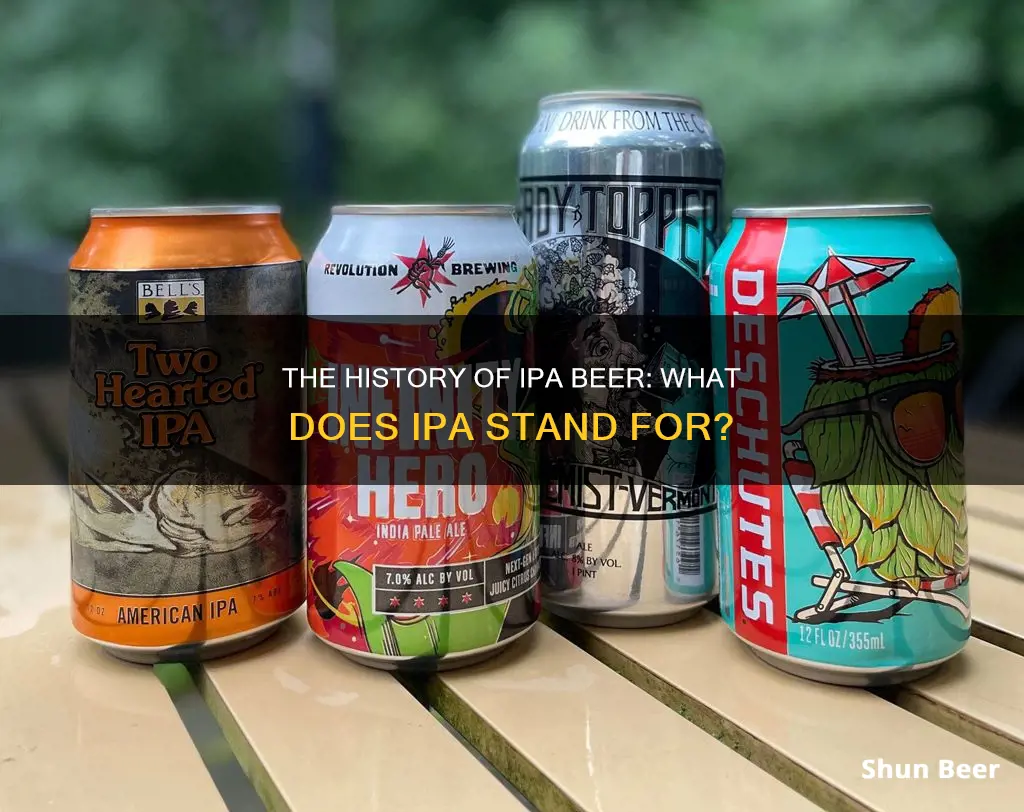
India Pale Ale, or Indian Pale Ale, is a style of pale ale that is brewed with more hops to give it a stronger flavour. The acronym IPA stands for this style of beer, which is now so popular that it can be considered a regular beer. The name dates back to the British Empire and their colonies, when British sailors and soldiers wanted a beer that would survive the long journey to India and its hot, humid temperatures.
What You'll Learn

IPA stands for Indian Pale Ale or India Pale Ale
India Pale Ale, or IPA, is a style of beer that is characterised by its strong hoppy flavour. The name is derived from the beer's history, dating back to the days of the British Empire and its colonies. British sailors and soldiers, seeking a beer that could withstand the long journey to India, developed a brew with a higher alcohol content and more hops, which acted as a preservative. This resulted in the creation of Indian Pale Ale or India Pale Ale, which has since become a popular beer style worldwide.
The IPA has a fascinating history that began during the British colonial era. The beer was originally brewed in the UK and exported to India, which was under the control of the British East India Company until 1858. The hot and humid climate in India posed a challenge for beer preservation, so the IPA was designed to survive the long journey and changing temperatures. The higher alcohol content and increased use of hops acted as natural preservatives, ensuring the beer remained drinkable despite the challenging conditions.
The exact origins of IPA are somewhat disputed. One common story credits a brewer named Hodgson with pioneering the drink specifically for export to India. However, some claim that Hodgson may have simply been lucky, as his "October beer" happened to be well-suited for the journey and gained popularity among traders. Regardless, it is certain that IPA was indeed exported to India and became known for its distinctive hoppy flavour.
Over time, the IPA evolved beyond its practical origins and became an art form. Brewers experimented with different hop varieties to enhance the flavour rather than for preservation purposes. This led to the creation of numerous unique types of IPAs, such as the New England IPA (also known as a Hazy IPA or East Coast IPA), the West Coast IPA, and the Double or Imperial IPA, which features a higher alcohol content and an even stronger hoppy flavour.
Today, the IPA has become one of the most influential beer styles of the last few decades, with its bold and distinctive taste appealing to beer enthusiasts worldwide. The craft beer revolution, particularly in the United States, has further propelled the popularity of IPAs, with brewers experimenting with classic European styles and creating new variations. The flexibility and diverse flavour profiles of IPAs have contributed to their enduring appeal, solidifying their place as a staple in the craft beer world.
The Founding Story of Guinness Beer
You may want to see also

IPAs were created by British sailors to withstand long journeys
India Pale Ale, or IPA, was created to withstand long journeys during British colonial times. Sailors needed a beer recipe that would be easy to preserve on the long trips from Britain to India. The weather in India was too hot and too wet to brew good beer.
The IPA was born out of the British Empire's trade relations with the colonies. Beer was one of the most sought-after products from Britain, and London-based brewer Hodgson realised that some of his existing pale ales, which were hoppier and stronger than usual, were particularly suited to long sea travels. Hops are a powerful natural preservative, and the high alcohol content in these beers also helped to preserve them for longer.
Hodgson's beers could reach the Indian colonies in decent condition even after six weeks at sea. This presented a good business opportunity for brewers, who adapted their recipes to create pale ales that were even better suited to the long journey. These specific versions of pale ales became known as India Pale Ales (IPAs).
IPAs were formulated to survive long voyages by sea better than other styles of the time. While they were not the only beers that could be successfully shipped to India, with porter also making the journey, the IPA became the preferred option.
The IPA has come a long way since its colonial origins, but the hoppy quality has mostly remained the same. Today, IPAs are known for their bold and distinctive taste, with very direct hop flavour, and are one of the most popular beer styles in the UK and the US.
India's IPA Beer: A Cultural Fusion
You may want to see also

IPAs are best enjoyed fresh and cold
IPAs, or India Pale Ales, are best enjoyed fresh and cold. This is quite different from the original intention behind the creation of IPAs, which were brewed to survive long journeys from Britain to India during colonial times. The hot and wet weather in India was not conducive to brewing good beer, so sailors needed a beer recipe that would be easy to preserve on long trips. Thus, the India Pale Ale was born, with lots of hops that could survive without going bad.
Today, IPAs are enjoyed around the world, with modern American IPAs typically ranging from 6-7% ABV. While IPAs can be stored for several weeks and still retain their flavour, they are best enjoyed fresh. According to brewers, the ideal serving temperature for an IPA is around 50 degrees Fahrenheit, which is much warmer than a beer pulled directly from the fridge. Allowing the beer to warm up a little will enhance the drinking experience by revealing the IPA's more delicate flavours and aromas.
The temperature of an IPA is crucial to the drinking experience. Revolution Brewing barrel program manager Marty Scott explains that "most beers, and IPAs in particular, will become more expressive as increasing temperatures drive CO2 evolution and hop compound volatilization from the liquid." However, he cautions that "too warm, and your nice refreshing cold beer is anything but." Thus, it is important to let an IPA sit for a few minutes before drinking to bring it to the ideal temperature.
The freshness of an IPA is also an important factor. While IPAs can be consumed several weeks after production, they are best enjoyed fresh to get the full range of flavours and aromas. For the best experience, it is recommended to drink an IPA within the first 3 weeks of production.
Guinness Beer: Less Is More, But Why?
You may want to see also

IPAs are known for their bitter, fruity and floral flavours
IPAs, or India Pale Ales, are known for their bitter, fruity, and floral flavours. The beer style was invented in Britain during the colonial era. British sailors travelling to India loaded barrels of beer with hops, a preservative, to stop the beer from spoiling during the long journey. The hops infused the beer with a bitter taste, and the modern IPA has evolved from this process.
Today, IPAs are best enjoyed fresh and cold, rather than from an oak barrel! The bitterness of an IPA is determined by the brewing process and the types of hops used. Hops are the flowers of the female plant Humulus lupulus, a fast-growing climbing plant and a member of the hemp family. There are dozens of distinct hop varieties, and they all belong to the same species. Each hop variety has a specific mix of aroma chemicals, with a hierarchy of desirability in the marketplace.
Citrusy IPAs are the most widespread and popular, with non-citrus fruit IPAs also available. Tropical fruits such as mango, guava, and passion fruit are expensive but popular additions to IPAs. Brewers also add herbs and spices to their IPAs, with rosemary, thyme, coriander, sage, basil, ginger, and cardamom all used to create subtle aromas.
The different types of IPAs include West Coast, New England, Session, Double or Imperial, and British. A West Coast IPA is bitter and balanced with an exceptionally clean, crisp body, higher carbonation, and big tropical fruit notes. A New England IPA is unfiltered, hazy, and has extremely low bitterness with intense fruity flavours. A Session IPA has less alcohol, usually below 5% ABV, and is perfect for drinking in repeat sessions with friends. A Double or Imperial IPA has a higher hop concentration, more malt, and a higher ABV (usually over 7%). Finally, a British IPA is malty, bitter, and one-noted.
Guinness Blonde Ale: Wheat Beer or Not?
You may want to see also

Double IPAs have more hops and more malt than regular IPAs
India Pale Ale, or IPA, is a style of pale ale that emphasizes hop flavours and aromas. The name has its roots in the British Empire and its colonies. During British colonial times, sailors sought a beer recipe that would be easy to preserve on long trips from Britain to India. Thus, they brewed a beer with lots of hops that could survive long journeys without spoiling, and the India Pale Ale was born.
Today, IPAs are known for their bold and distinctive taste, and the style has evolved into its own unique category. Modern American IPAs tend to be around 6-7% ABV, but there are many variations, including the Double IPA or Imperial IPA.
Double IPAs, as the name suggests, have more hops and more malt than regular IPAs, resulting in a much bigger beer. They have a higher alcohol content, typically ranging from 7.5% to 10% ABV, and a more pronounced hop flavour and aroma due to the increased amount of hops used in the brewing process. The higher hop concentration also contributes to a bolder and often more bitter taste profile.
The key to a well-rounded Double IPA is achieving a precise balance between the malt sweetness and hop bitterness. The additional malt helps to counteract the extra bitterness generated by the hops. The result is a beer with a smooth texture and a complex flavour profile that can include notes of citrus, stone fruit, pine, tropical fruit, berry, melon, caramel, and toasty flavours.
The "double" in the name signifies an amplified or intensified version of a standard IPA, and Double IPAs are often described as bold, bitter, refreshing, fruity, light, crisp, heavy, and intense. They pair well with spicy dishes such as Indian, Mexican, and Cajun food, as well as roasted and grilled meats and fish.
Brewing a Double IPA involves a process similar to brewing a regular IPA, but with adjustments to accommodate the higher alcohol and hop content. More malt and hops are required to achieve the desired alcohol level and hop character. The bitterness levels in Double IPAs can range from sixty-five to ninety IBUs, and it is crucial to have a strong malt backbone to balance the bitterness and create an enjoyable drinking experience.
Guinness Beer Preservatives in NY: What's the Deal?
You may want to see also
Frequently asked questions
IPA stands for Indian Pale Ale or India Pale Ale.
The name comes from the beer's history, which dates back to the British Empire and their colonies. It was brewed in the UK in the 1780s and became popular among British soldiers and administrators serving in India.
IPA is a style of beer that is made with more hops, giving it a stronger flavour. It is a type of pale ale.







